General Information
As with all fresh meat, please ensure your Christmas produce is stored in a fridge at an ideal temperature of 4.0C until ready for cooking. If you have chosen to freeze your meat, please following the defrosting guidelines further down this page.
Our Turkey Crowns will come sealed in a vacuum packed bag for freshness. You may notice an odour being released when the bag is first opened, which is simply the concentration of the turkey juices being released from a contained atmosphere. This will quickly dissipate once the joint is placed out in the open.
We’re often asked for instructions on how to cook our Christmas poultry, but the truth is there’s so many recipes and methods out there that you’re really spoilt for choice. To help make things easier however we’ve included the most common cooking times and methods.
Turkey cooking times
The cooking times apply to both whole turkeys and boneless crowns (boneless turkey breasts), however the cooking times for boneless joints are generally shorter due to their reduced weight. As advised by British Turkey, the temperature of your oven should be 190C/170C fan/gas 5 and the cooking time calculated as follows:
Under 4kg: 20 mins per kg plus 70 mins
Over 4kg: 20 mins per kg plus 90 mins
Remember to weigh your turkey with any stuffing that is under the skin or bacon (or any other additions) wrapped around it and finally, to check that it is cooked properly.
How do I know my turkey is cooked?
Ideally, test it using an oven thermometer. Ovens vary and if you have put anything else in to cook at the same time, this can also affect the cooking time.
The internal temperature of your turkey should be 70C when it is ready. This is the recommended temperature for cooked turkey according to the Food Standards Agency. You MUST then leave it to rest for 20 minutes, and it will continue cooking through.
Before serving your turkey, always check that the meat is steaming hot throughout, there is no pink meat visible and when you cut into the thickest part, the juices run clear.
How long does it take to defrost a turkey?
Make sure your turkey is properly defrosted before cooking. Use these timings as a guide and check the temperature of the defrosting environment.
- In your fridge: set at 4C or below, allow 8-12 hrs per kg.
- In a cool room: which must stay below 17.5C, allow 3-4 hrs per kg.
Check the turkey is thawed by looking inside the cavity for ice crystals and by pushing the point of a knife into the thickest part of the meat.
Basic turkey crown recipe
Ingredients:
- 50g butter
- 1 turkey crown
- Seasoning
Method:
- Heat oven to 190C/170C fan/gas 5. Smear the butter all over the turkey crown and season all over with salt and pepper.
- Put in a roasting tin, skin-side up, and roast for 70 mins plus 20 mins per kg, or until the internal temperature reaches 65-70C.
- Remove the turkey from the oven and rest in a warm place for 20 mins. Don’t cover it if you want the skin to stay crisp.
Classic whole turkey recipe
Ingredients:
- 1 onion, quartered
- fresh bay leaves, to flavour and serve
- Bronze turkey, giblets removed
- 1 quantity of stuffing
- 85g butter, softened
- 1 whole nutmeg
- 10 rashers streaky bacon
- glass red wine, such as Merlot
- Pigs in Blankets
Method:
- Heat oven to 190C/fan 170C/gas 5. Put the onion and a large sprig of bay in the cavity between the legs. Now pack half the stuffing into the neck end, pushing it towards the breast. Secure the neck skin in position with skewers and tie the turkey legs together at the top of the drumsticks to give a neat shape.
- Weigh the turkey and calculate cooking time at 20 mins per kilo, plus 90 mins. (You may need to use your bathroom scales.)
- Put a large sheet of extra-wide foil in a large roasting tin, then put the turkey on top. Smear the breast with the butter, grate over half the nutmeg and season well. Cover the breast with bacon, pour over the wine, then loosely bring up the foil and seal well to make a parcel.
- Roast in the oven, then 90 mins before the end of cooking, open the foil, discard the bacon, and drain off excess fat from the tin. Leaving the foil open, return the turkey to the oven to brown, basting with the juices several times. Then 30 mins before the end of cooking, place pigs-in-blankets and stuffing of your choice around the turkey, or cook in a separate lightly oiled tin.
- To test whether the turkey is cooked, push a skewer into the thickest part of the thigh – the juices should run clear. If they are pinkish, cook for 15 mins more, then test again.
- Transfer the turkey, stuffings and pigs-in-blankets to a platter, cover with foil, then a couple of tea towels and allow to rest for up to 30 mins before carving. This gives the juices time to settle back into the meat, ensuring that the turkey will be juicy. Garnish with sprigs of bay
You’ll also find lots more recipes and festive food inspiration from our friends at BBC Good Food: https://www.bbcgoodfood.com/recipes/collection/turkey
Brisbourne Goose Cooking Guide

To calculate the cooking time: cook for 10 mins at 240C/fan 220C/gas 9, then reduce to 190C/fan 170C/gas 5 and cook for 20 mins per kg for medium-rare, 32 mins per kg for more well done, plus 30 mins resting.
Method:
- If you have chosen to freeze your goose at home, thaw using the following guidelines: In a fridge at 4°C (39°F), allow around 10-12 hours per kg. In a cool room (below 17.5°C, 64°F), allow approximately 3-4 hours per kg. Before cooking, make sure there aren’t any ice crystals in the bird’s cavity. Test the thicker parts of the goose with a fork to check the meat does not feel frozen.
- If the goose is ready-trussed, then loosen the string and pull out the legs and wings a little – this helps the bird cook better.
- Check the inside of the bird and remove any giblets or pads of fat. Using the tip of a sharp knife, lightly score the breast and leg skin in a criss-cross. This helps the fat to render down more quickly during roasting.
- Heat the oven to 240C / Fan 220C and season the cavity of the goose generously with salt
- If you want to give the bird a nice golden skin, brown in a large frying pan (or a heavy-based roasting tin), using a couple of tbsp olive oil. Holding the bird by the legs (you may like to use an oven glove), press it down on the breasts to brown.
- Once browned, place the bird in the roasting tin. Drizzle with 3 tbsp clear honey and sprinkle with 1 tbsp thyme leaves.
- Roast for the calculated time, turning the heat down after 10 mins to 190C/fan 170C/gas 5. Cover the goose with foil if it is starting to brown too much.
- Every 30 mins or so, baste the bird with the pan juices, then pour off the fat through a sieve into a large heatproof bowl. You will end up with at least a litre of luscious fat – save this for the potatoes and other veg.
- At the end of the cooking time, leave to rest for at least 30 mins, covered loosely with foil. The bird will not go cold, but will be moist and much easier to carve.
Enjoy!
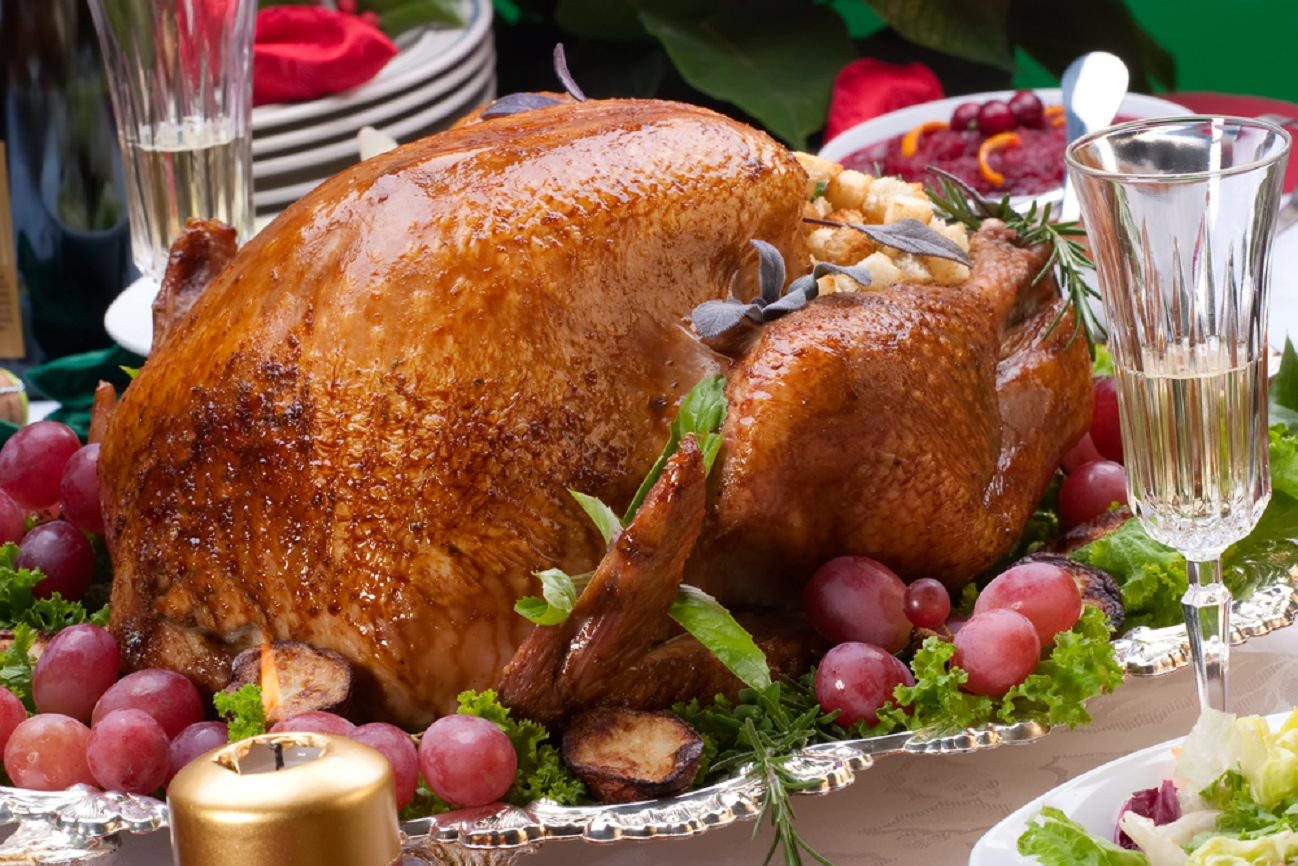
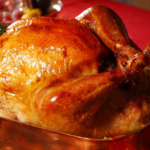
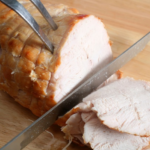
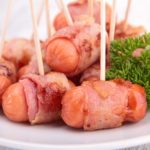
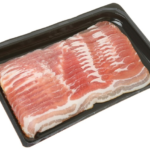
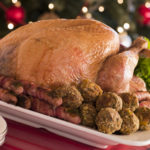
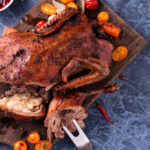
2 thoughts on “Christmas Cooking Information”
Alisha Ross
Replied onThis recipe looks awesome!!! Since I don’t use grain flour, do you think almond or coconut flour would work well as a substitute? Thanks!
Regards
Ross Alisha
Rose Martine
Replied onThis looks amazing! Nice work. I’ve never cooked with tamarind before.
Regards
rose martine